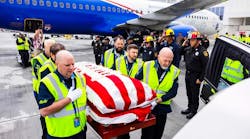The month of March is IA renewal time! During the first part of this two-part renewal ritual 13,000 FAA airframe and powerplant (A&P) technicians who hold an IA dutifully fill out a FAA 8610-1 form, usually at the last minute, and send it in to one of the 90 local FAA district offices for processing before the 31st of the month.
The 8610-1 form must show the FAA that the A&P meets at least one of the following minimum IA renewal requirements: One annual inspection or two completed Form 337s for each 90 days they held the IA; show proof that he or she performed or supervised and approved at least one progressive inspection; attend and successfully complete an eight-hour refresher course acceptable to the FAA; or pass an oral test given by an FAA inspector.
In my 27 years in aviation maintenance I have never heard of any IA stouthearted or desperate enough to take advantage of that last renewal option.
IA meetings
The second part of the renewal ritual is the IA meeting. There are usually three kinds of IA meetings with each one a reflection of the local FAA office priority toward maintenance.
Informal meeting: IA might meet an FAA inspector at the local office or the inspector might visit the IA at his place of business. Usually a small discussion on the virtues of good maintenance takes place, then the IA’s card is signed off for another year, and a handshake seals the transaction. The net result is both the IA and the FAA inspector are left with 10 minutes of warm and fuzzy feelings and then it’s back to business as usual.
Required pain and suffering (RPS) meeting: The RPS meeting usually takes the form of a three-hour local district office gathering held in an inconvenient place at an inconvenient time.
A major player in the RPS meeting is a brand new FAA airworthiness inspector who, as part of the rights of passage to be a journeyman inspector, must memorize the two-hour government sermon for IAs (Dated 1973) covering semi-exciting subjects such as correctly filling out FAA Form 337 and logbooks.
In addition the new inspector must, on his own, come up with a 10-minute speech extolling the virtues of sending in M&D reports.
The remaining time left is spent standing in line to get the IA card signed and listening to your stomach attempting to digest the day-old stale doughnut and acid-based cup of coffee you had at the break.
IA maintenance seminar meeting: This is a true maintenance training extravaganza sponsored by the FAA in partnership with industry.
The meetings are designed to be large enough to accommodate A&Ps, repairmen, Part 147 A&P schools students and instructors. The average meeting size is about 250 persons.
Guest speakers, industry and FAA representatives, using slides and videotapes, inform the audience of the latest Federal Aviation Regulations (FAR) rule changes, maintenance techniques, new equipment and products, and discuss what’s happening with the industry nationwide.
These meetings usually last eight hours or more so the technician can, with one meeting, renew his or her IA and meet the requirements of FAR 65.93(a)(4), which requires a minimum of eight hours of instruction within the preceding 12 months.
FAA offices that hold these IA maintenance seminars, like the kind held in Reno, NV; Lafayette, LA; and Teterboro, NJ, truly put enormous time, money and resources into ensuring that the time an IA must spend away from his job is time well-spent.
The payback for the IA who attends such a meeting is that the technician is better informed and thereby better able to compete in a tough industry. The payback for the FAA office is fewer maintenance-related accidents and better communication with the industry.
With the industry aware of the success of the IA maintenance seminars one wonders why any IA would be satisfied with a warm and fuzzy renewal or remain willing enough to endure another RPS. Clearly, the IA maintenance seminar meeting has the most to offer. By writing to your local FAA district office you may be able to convince the district manager to organize such a seminar. Change is possible if enough of you want it to happen.
Some tips for becoming an IA
Practice your craft! Fill out imaginary logbooks and Form 337s. As an IA you will be signing off annuals and progressive inspections, looking up Airworthiness Directives, filling out Form 337s and making up weight and balance reports. You are not only preparing for a tough FAA exam you are preparing for a career.
You should know what acceptable and approved data is, what field approvals are, the difference between major and minor, maintenance recordkeeping requirements and the duties and responsibilities of an IA by heart.
Work with your local FAA airworthiness inspector. Stop in and talk over the test and ask for suggestions and advice on preparing for it. Short of giving the test away I have never known of an FAA inspector to refuse this kind of a request for help. Also give the inspector enough notice to schedule the test on the date when you want to take it.
Oh yes, beware of IA courses that offer “the quick and easy way” to becoming an IA. These courses teach you the only the test – not the profession. No one can make you a “real” IA in three days, or even a week, without months of preparation on your part. Quite frankly, nothing in aviation is as sad or dangerous as a brand new IA trying to make an airworthiness decision based only on what he or she learned during a weekend course. If you fail the IA test, and almost half the A&Ps miss the first time, go stand in a corner and allow yourself 30 seconds of self-pity. Then promise yourself that in the next 90 days before you are allowed to take the test again that you’ll be even better prepared.
IA defined
There are really three definitions of an IA – and all three are as different as they are true.
The regulatory answer is: An IA is an individual who meets the requirements of FAR sections 65.91 through 65.95. Translation: An individual who has been an A&P for at least three years and active for at least two of those years.
He or she must have a base of operations along with the necessary equipment facilities and inspection data available to perform the inspections. Oh yes, the A&P must pass a killer of an FAA test that can last as long as six hours.
The industry answer is: An IA is the aviation equivalent of an 800-pound gorilla. No single individual in our maintenance profession exercises more power, more authority and has more responsibility under the FAR than an IA.
A few examples of an IA power are:
1. An IA can ground an aircraft after an inspection by simply giving an owner/operator a piece of paper saying the aircraft is unairworthy and providing him with a list of airworthiness discrepancies.
2. A 23-year-old brand new IA can tell a 63-year-old technician with 45 years of sheet metal experience to redo a major repair or alteration if it doesn’t meet the IA’s satisfaction.
3. A single IA can approve for return to service more makes and models of aircraft than the average Part 145 repair station can.
4. An IA can approve for return to service aircraft or components on which major repairs or major alterations have been accomplished.
The individual IA’s answer: An IA is a technician with both a strong sense of purpose toward safety and blessed with a better than average amount of self-confidence in his or her ability to do the job.
IAs are ambitious in a positive way, because they took the long hard road to earn the IA. They are for the most part average technicians with above average persistence. They simply wanted to be the best in their profession.
IAs are teachers because they guide and instruct technicians on the correct way to do their job.
IAs are arbitrators and referees on the hangar floor who settle airworthiness disputes between technicians, owners and even management. An IA is a world-class worrier. Most A&Ps don’t see the concern for safety on the IA’s face because the IA has learned to hide it well. But the result of each airworthiness decision etches another worry line around the eyes or cuts deeper into the furrow on the brow.
An IA is a loner, for the responsibility for those decisions rests on his or her shoulders alone. For no committee, no adviser, nobody else will sign the logbooks but the IA.
An IA is an aviation maintenance professional.
This article first appeard in the March/April 1992 issue of Aircraft Technician.


